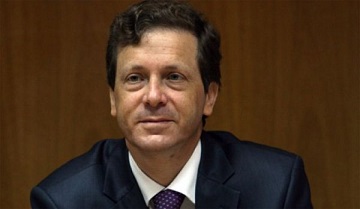PUBLICATIES - NPK-BERICHTEN
The Zionist Union's plan for a Palestinian Bantustan door Ben White
 saac
saac
Isaac Herzog, chairman of the Israeli Labor Party and part of the Zionist Union
Since 2009, Netanyahu and his allies in the Knesset have frustrated the efforts of the U.S. and international community to advance the official peace process. Just two days ago, Netanyahu clarified that should he win re-election, there will be "no concessions and no withdrawals [from the Occupied Palestinian Territory]."
But what of Herzog and Livni? What if, when the dust settles, the Zionist Union is invited to head the next Israeli government? What is the alliance's position on the Palestinians and the peace process? Well now we know. On Sunday, the Zionist Union published its platform, and the picture is clear: disregard for international law, and a blueprint for a Bantustan.
A "final status agreement", the Zionist Union states, "will be based on the following principles":
Demilitarizing the Palestinian state, keeping the settlement blocs in Judea and Samaria [the West Bank] under Israeli sovereignty; strengthening Jerusalem and its status as the eternal capital of the State of Israel and ensuring religious freedom and access to the holy sites to all religions, along with maintaining Israeli sovereignty; resolution of the Palestinian refugee problem through the establishment of a Palestinian state and not within Israel.
What does this indicate about the borders of a future Palestinian state? Jerusalem – including the illegally annexed, occupied east – will be "the eternal capital of the State of Israel" with "holy sites" under "Israeli sovereignty." Meanwhile, "the settlement blocs" in the West Bank will also remain "under Israeli sovereignty."
The Zionist Union does not expand on the crucial point of what it means by the "settlement blocs", but there are some clues. A year ago, Herzog told an official from UK-based Israel lobby group BICOM that "for Zionism to prevail and to succeed we must make sure that Gush Etzion and Ma'ale Adumim will be part of Israel forever."
Herzog made a similar remark recently, declaring that "Gush Etzion must be part of Israel for eternity." But it was on 1 March that he was most explicit, in response to a question about what land he would keep in a final settlement with the Palestinians.
"In the ideal world", Herzog replied, "I would like to keep it all." But ultimately, he added, he would keep the Gush Etzion, Ma'ale Adumim and Ariel settlement blocs, and the Jordan River would be his so-called security border.
There is no consensus definition of what constitutes the 'settlement blocs'. Some identifyfive (Ariel, Modi'in Ilit, Ma'ale Adumim, Gush Etzion, Givat Ze'ev), while others talk of seven (adding to the previous five the Jordan Valley and a corridor connecting the Hebron settlements).
As even mainstream Israeli NGO Peace Now puts it, "these 'blocs' have no legal definition or standing, either under Israeli or international law", and "the settlements they contain are not recognized by the Palestinians or the international community as having any special status compared to other settlements, either now or in terms of a future peace agreement."
Peace Now also notes that "Israel has always left the size and borders of the blocs undefined, allowing their informal borders to grow year after year, as construction has systematically thickened the blocs." Ariel, Ma'ale Adumim, and Gush Etzion are all "consensus" blocs – their permanent annexation by Israel a position shared by both Netanyahu and Herzog.
The PLO's Negotiation Affairs Department has highlighted the impact of the 'blocs' being kept under Israeli sovereignty:
Simply, it would mean recognizing Israel's illegal annexation of Occupied East Jerusalem, Israeli settlement presence as deep as 22 kilometres inside the Occupied West Bank taking valuable natural resources (Ariel), Israeli control over the Jordan Valley and the splitting of the Occupied West Bank in two (Ma'ale Adumim), and the annexation of rich Palestinian agricultural and natural resources and heritage sites in the Bethlehem/Hebron area (Gush Etzion).
The Zionist Union platform also vows to renew "economic and security-based cooperation with [the Jordanian] government through the implementation of the plans for the development of joint trade, industry and tourism zones along the Jordan Valley and the Arava..." Trade, industry and tourism zones along the Jordan Valley – in other words, not just a "security" presence.

Thus the final map of the Palestinian 'state' in the vision of the Zionist Union is similar to the kind ofBantustan proposed by another former Labour man, Ehud Barak, with borders now shaped by the Apartheid Wall and further Israeli colonisation of the Jordan Valley. (See 'guide' map illustration)
Herzog-Livni's platform also makes clear that there will be no respite for the battered Gaza Strip. "A government headed by the Zionist Union", the document reads, "will create significant deterrence vis-a-vis Hamas and the other terror organizations" and will "take action to weaken and isolate these in order to bring about the demilitarization of the Gaza Strip."
But it is the promise of permanently colonising key portions of the West Bank that is most significant. While the Zionist Union says it will "allocate the necessary legal and diplomatic resources required" to "fight against the international boycott and delegitimization movements", with its Bantustan blueprint it is guaranteeing that Israel's isolation will only deepen.
Ben White in Middle East Monitor 10 maart 2015
The author is grateful to Ofer Neiman for the translation.
Archief NPK-berichten

 Er zijn inmiddels meer aanbieders van Palestijnse producten.
Er zijn inmiddels meer aanbieders van Palestijnse producten.